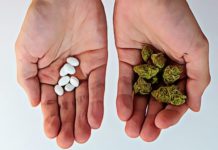awareness regarding the dangers of smoking cigarettes in the addiction treatment system.
“Not always but often smoking is not addressed,” he said. “People in drug abuse treatment end up dying of tobacco-related causes downstream a lot more often than people in the general population because they smoke a lot more.”
The reviewed surveys showed an 84 percent smoking rate for patients in addiction treatment, while the surveys from matched populations — treated and nontreated groups — showed a 31 percent rate. The overall difference in pooled surveys was 52 percent.
“The [study] shifted my thinking to either realize or figure out what it is about nicotine that is contributing to drug use,” he said. “In addition to these cultural factors, I think there are biological factors. So it’s encouraged me to try to understand that if we try to address this problem only by saying, ‘oh, let change the treatment culture,’ that’s a good idea, but I think that’s probably not enough. I think that’s only part of the picture; it’s encouraged me to try to understand and be aware of what’s happening on the biological side that nicotine is an addictive drug and that it potentiates and strengthens the effects of other drugs.”















